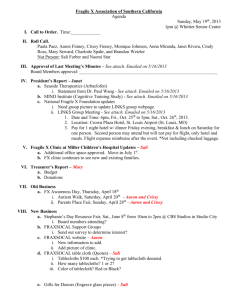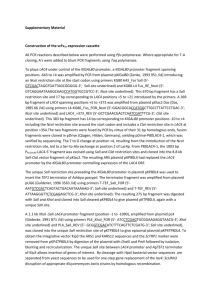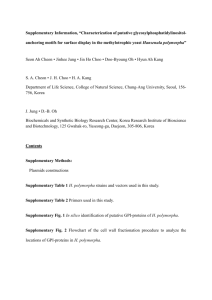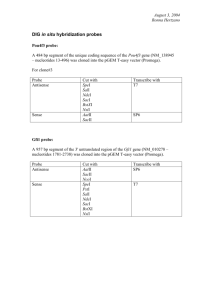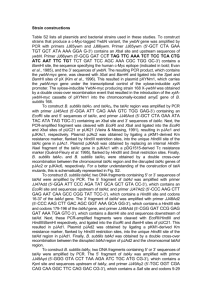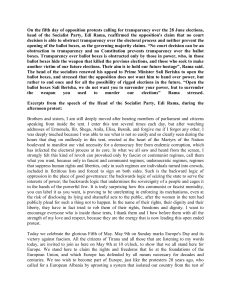Speech impediment and Drama therapy intervention with an
advertisement
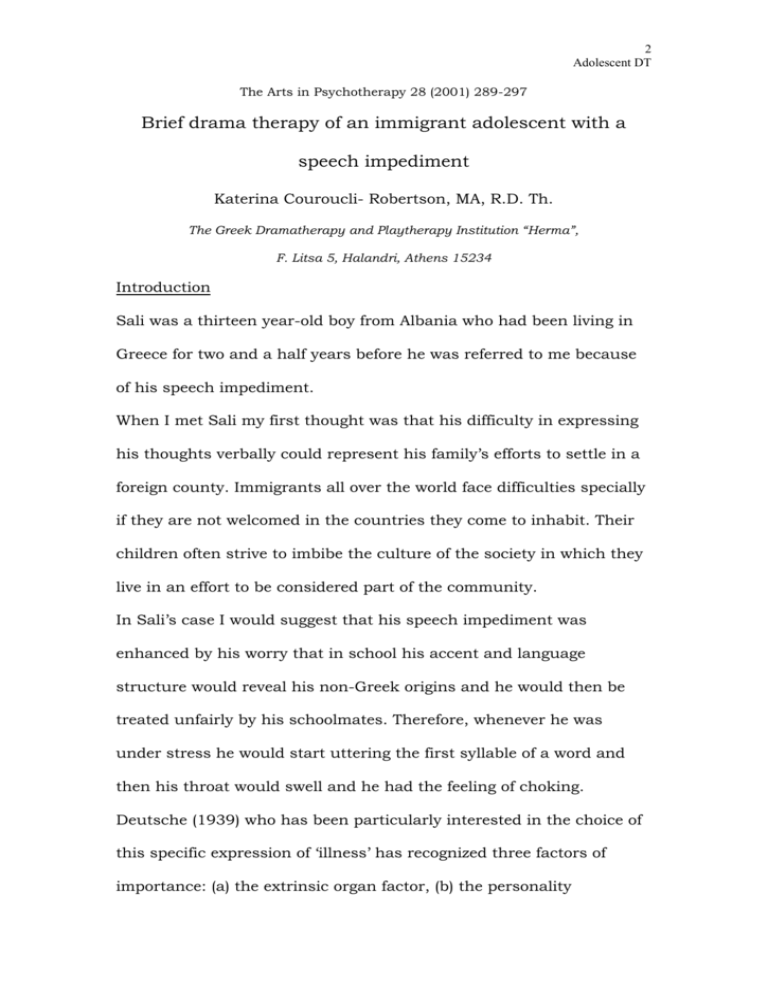
2 Adolescent DT The Arts in Psychotherapy 28 (2001) 289-297 Brief drama therapy of an immigrant adolescent with a speech impediment Katerina Couroucli- Robertson, MA, R.D. Th. The Greek Dramatherapy and Playtherapy Institution “Herma”, F. Litsa 5, Halandri, Athens 15234 Introduction Sali was a thirteen year-old boy from Albania who had been living in Greece for two and a half years before he was referred to me because of his speech impediment. When I met Sali my first thought was that his difficulty in expressing his thoughts verbally could represent his family’s efforts to settle in a foreign county. Immigrants all over the world face difficulties specially if they are not welcomed in the countries they come to inhabit. Their children often strive to imbibe the culture of the society in which they live in an effort to be considered part of the community. In Sali’s case I would suggest that his speech impediment was enhanced by his worry that in school his accent and language structure would reveal his non-Greek origins and he would then be treated unfairly by his schoolmates. Therefore, whenever he was under stress he would start uttering the first syllable of a word and then his throat would swell and he had the feeling of choking. Deutsche (1939) who has been particularly interested in the choice of this specific expression of ‘illness’ has recognized three factors of importance: (a) the extrinsic organ factor, (b) the personality 3 Adolescent DT organization at the time, and (c)the action of the neurosis in the environment. If these three factors coincide the direction in which the choice of organ tends is definitely laid down. The development of the symptoms depends on the interrelationship of these three factors, so that if all three factors can be known the course can be prophesied (Deutsche 1939, p.20). Sali was a young adolescent who felt that many opposing issues were taking place inside him all at once. His mother was a loving and caring person as well as a pushy one, Sali loved her dearly but also wanted to rebel against her. Storr (1972) has stated that one cannot wholeheartedly love those whose authority restricts one’s autonomy; and this is an inescapable condition of early childhood (Storr 1972, p.140). Moreover Sali was an immigrant who was making a great effort to settle in a new country while at the same time he felt he should remain proud of his own nationality. He loved music and dancing but wondered whether his older brother’s comments that these activities were girlish were true. Storr (1972) has noted that one observation consistently reported by psychologists using various tests is that their male creative subjects show high scores on scales measuring ‘femininity’ (p. 241). Sali showed interest in becoming a hairdresser but worried because he was told by his family that this profession attracts ‘ homosexuals’. 4 Adolescent DT It could well be that Sali’s biggest problem was based on the fact that he was the type of person who always wanted to please others and found it difficult to show negative feelings. He would adopt other people’s views in order to gain their approval. At the same time he was also beginning to establish his own identity. Dunbar & Hoener (1948) suggest that: Our therapeutic experience indicates clearly that in somatic diseases, just as in abnormal behavior, the chances of successful treatment increases in proportion to the adequacy of ego organization if one allows for the extent to which irrecoverable structural damage has occurred (p.659). In the ten dramatherapy sessions we shared, opposing sides of Sali’s character kept on appearing in a very distinctive way and we decided to give them the names of the Greek Gods Athena and Poseidon. These two gods could represent his animus and his anima, his logic and his strength, his mother and his father, Albania and Greece and as later on it was revealed his identity under his Albanian name Sali and his identity under his Christian name Alexander. Jung (1974) states: I consider it impossible for anyone without the knowledge of mythology and folklore and without some understanding of psychology of primitives and of comparative religion to grasp the 5 Adolescent DT essence of the individuation process, which, according to all we know, lies at the base of psychological compensation (p.76). Sali might not have known Jung but he knew Greek mythology well enough and this gave him another perspective which helped him understand the symbolic meaning of our dramatherapeutic work. By dramatherapeutic work I mean working with personal issues on a metaphorical and symbolic level. The British Association of Dramatherapists (1992) has adopted the following definition: Dramatherapy has as its main focus the intentional use of healing aspects of drama and theatre as the therapeutic process. It is a method of working and playing that uses action methods to facilitate creativity, imagination, learning, insight and growth. Presenting Concerns Sali was just over thirteen when his mother asked for my intervention. During her very first visit she expressed her decision to make any sacrifice in order to help her younger son overcome his speech difficulty. She explained that his impediment had intensified since he had started going to a Greek school. From the information she gave me it would appear that Sali was suffering from psychological distress. Sanders (1996) classifies clients with psychological distress as those: Who are suffering from anxiety or depression, or a combination of both problems. Rather than asking for help for emotional 6 Adolescent DT issues, the client will focus on and be concerned about the physical symptoms, at least initially, and may believe that they are physically ill (p.5-6). Sali and his family were immigrants from Albania; his father was a Greek Christian whereas his mother was a Moslem. They had come to live in Greece two and a half years before I met them. One of the first and fairly basic issues that arose in the therapy was Sali’s name. His mother introduced him to me as Alexander but during our first meeting I caught her calling him by another name. When I asked her again about his name she explained that in order to become more acceptable in Greece and at school particularly it was customary for Albanians to give their children and themselves Greek names with or without the ceremony of a christening. Sali was the boy’s original name but his name had been changed to Alexander when he was christened as a Greek Christian Orthodox. I asked Alexander how he would prefer to be called by me during our sessions. He answered he did not mind and left it up to me. I then tried to explain to him that the reason I wanted to know was not for my benefit but for his. I felt it would be important for him to realize and decide which of the two names he considered really represented him. After a few seconds of thought he decided that ‘ Sali’ was the name he preferred and thus from then on I called him ‘ Sali.’ This custom reminded me of the customs that certain cults have, when they give new initiates different names in order to cut off their connections from their past. 7 Adolescent DT Sali had a brother four years older than him who being older was perhaps more certain about his identity and thus had refused to have his name changed. Sali’s father’s name was Greek and his mother’s name sounded Greek in its shortened form. So it was Sali alone of the entire family who had been given another name. He was the one with a speech impediment and it seemed to me that he was the one, who had to try much harder than the rest of his family members to become Greek. I saw Sali with his mother during a preliminary meeting where I explained the way I work and I took down his case history. Sali’s mother thought that she might have caused Sali’s problem as she felt she had pressed him too hard to learn and to practice the violin a few years earlier. Between the age of seven and eleven before their coming to Greece, Sali in addition to his school homework had been pressed by his mother to take violin lessons. He did an hour’s lesson everyday and then had to practice for another three hours late into the night. Sali said that although he wanted to become a great violinist he found the pressure of the practice very stressful and was glad that he had stopped taking lessons and playing the violin when he came to Greece. When he was eight years old he complained of having severe stomachache and he went to hospital though nothing pathological was found. A year later he had similar symptoms plus a difficulty in breathing. Once again the doctors found no organic reason and 8 Adolescent DT suggested that these attacks were possibly caused by stress. This could be an indication that Sali was not sharing his emotions. According to Alexander Lowen (1975) : Any emotion, which cannot be released, is a stress for the muscles. This is true because an emotion is a charge, which presses outward for release. A few examples will illustrate these ideas. Sadness or hurt feelings are released through crying, if the crying is inhibited because of parental objections or for other reasons, the muscles, which normally react in crying, become tense. These are the muscles of the mouth, throat, chest, and abdomen (p.58) The two visits to the hospital would indicate that Sali was vulnerable to somatazing his difficulties. It was also clear from the very start that Sali’s mother had ambitions for her son and that she was an anxious person. We had difficulty in finding a time for our appointments as she worked all day long cleaning houses. At the time Sali came to me it seemed that his problem had moved from his stomach to his throat. Whenever he was asked to recite his lessons at school he often got stuck after uttering the first syllable and his throat swelled up giving him the sense that he would choke. His mother asked me whether I could give her a letter for the headmistress requiring that Sali should be examined only through his written work. During my interview with him I observed that although he occasionally stuttered, the stuttering was almost insignificant. Sali’s Greek was at a good level given that it 9 Adolescent DT was his second language. His mother also spoke Greek fluently whereas his father had some difficulty. On our first meeting Sali said that he was very fond of music and dancing and that he would like to become a hairdresser though both his mother and he had heard that in Greece most of the male hairdressers were homosexuals. According to Sali his brother had completely different interests and wanted to become a car mechanic. Maybe Sali’s preference was part of his effort to find his own gender identity. However, he was concerned that it might not be a socially acceptable choice. While working with Sali I discovered that he was a conscientious boy who was very eager to please and got on well with everyone apart from his brother. He was very close to his mother and said that he also got on well with his father although their relationship seemed to be more distant. Generally I felt that he wanted to give a good impression of his home life and found it difficult to say anything against his parents. At school he got on well with his classmates and the teachers. He was very much aware of the negative feelings many people in Greece had towards the Albanians and felt he and his family were discriminated against by people who did not know them. There is widespread discrimination in Greece against Albanians. They are generally looked down upon and often regarded with suspicion. They started coming to Greece in 1992 when the Albanian 10 Adolescent DT borders were opened, leaving behind them poor living conditions. There are currently between 250.000 and 500.000 Albanians officially living in Greece. The men mostly work as laborers and the women as domestic helpers. Dramatherapy sessions I saw Sali for ten sessions. During this time we did not work directly on his speech problem. My main aim was concentrated on helping him understand his identity as well as to discover and evaluate his emerging personality. He was eager to work and was able to follow the creative element in the dramatherapy sessions. I sensed from the very start that my work with Sali was going to be a challenge. I also felt I had to face many issues in as relatively a short time as possible and for that reason I stipulated ten sessions to start with. As a Dramatherapist I run a private practice and although I charged Sali’s mother half of my normal fee, the cost of the sessions she had to pay was a significant sum for her, bearing in mind the family’s monthly income. We decided that Sali and I would see each other for tens sessions and at the end of the ten sessions see whether he felt considerable improvement and thus, stop the treatment or whether he felt the need further sessions. Sali brought little information about his life to each session. At the beginning of our work together he had thought that our meetings 11 Adolescent DT would be similar to a school lesson and he was concerned to prove himself a good student. I tried hard to make him feel at ease, to help him understand that he was not going to be judged and that his knowledge was not being tested. My aim was to help him reach a better understanding of himself. In summarizing our work together I will begin with Sali’s last session (the tenth) as it was at this session that he pinpointed all the important issues he felt had come up for him during his therapy. Critical issues addressed in dramatherapy sessions At our last session I had all the pieces of work Sali had done during the ten sessions spread out in front of him. Sali remembered what each one represented and in which sequence he had made them. I then asked Sali to think about our sessions as if they were chapters of a book and find a title for the book as a whole as well as titles for each of the chapters. Sali named the book “My internal persona” and divided it into six chapters. Chapter 1 ‘Guiding my thoughts’ The first task I had proposed to Sali was to draw a story in six parts based on an assessment tool developed by Mooli Lahad (1992). The 12 Adolescent DT 6-PSM is a therapeutic technique that uses the story and storytelling in order to assist the individual reach self-awareness and improve internal and external communication. Using the 6-PSM method, the therapist asks the client to draw a story in 6 parts according to the following instructions: divide the page into six spaces; think of a main character- a hero or heroine - and make a picture of him/her in the first box; in the second draw his/her goal in life; in the third his/her helper; in the fourth any obstacles the hero or heroine has to face; in the fifth box draw the conflict or resolution that arises while trying to achieve the goal; finally draw the outcome in the sixth box. Sali had chosen Odysseus as his main hero, whose goal was to return to his own country. His helper on his journey was the goddess Athena and his enemy was Poseidon who was jealous of him. The outcome of the story was that Odysseus after many years of travelling and having faced many hardships reached the shores of his native land, Ithaca. He overcame his wife’s admirers and claimed his status as king of his island again. Through this story, it seemed to me that Sali wanted to find out whether his own journey had similarities to that of Odysseus. He had told me during our sessions that his dream was to earn enough money so that he could return to Albania, where he would establish himself as a professional of some sort. 13 Adolescent DT When we went more deeply into the Odysseus story he had made, it became clear to Sali that Athena and Poseidon represented two parts of himself: his intellect and his strength. These two did not always go hand in hand because he had such high expectations for himself. Sali saw Odysseus as guiding his own journey through life. Chapter 2 ‘The bad and the good persons inside me’ During this session Sali made two masks, one of Athena and one of Poseidon. He wore each mask and gave a statement while wearing them. Working with these two masks one could say that Sali discovered his animus and his anima as represented through the two gods. He found out that some of their seemingly different qualities overlapped. On the one hand, Athena was a female goddess who, was born from the head of her father and therefore, was very logical and always did the right thing. On the other hand, Poseidon was a male god who was eager to reveal his emotions especially anger. Sali realized that he was often afraid of letting his Poseidon come out. He began to understand that when his Poseidon was hampered his speech had difficulties in coming out. This realization was important for Sali because it made him understand that it was up to him to try and control his speech and maybe improve it in the future. 14 Adolescent DT Chapter 3 ‘My family tree’ During this session we worked on Sali’s family tree. I asked Sali to represent the males with triangles and the females with circles. Sali began by drawing his father’s parents and their five children, three boys and two girls and then he drew his mother’s parents who had four girls. Then he united his parents and drew himself and his brother on his tree. While drawing in his relations Sali had no trouble in remembering the names and status of his family members. When Sali finished his family tree going back three generations the first conclusion he came to was that every person in his family tree was alive. Personally I have never come across a family tree, of three generations, where no one had died. This realization made Sali feel that he had a strong family. Next Sali remembered his great grandparents from his father’s father’s side and his great grandparents from his mother’s father’s side and he drew them in as well. He remembered their names and the number of children they had had. He wasn’t sure of his other great- grandparent’s names so he did not put them in the tree. (Usually I don’t go that far back in a family tree with my clients but as Sali was young and had met these great grand parents I thought it was important for him to include them all). What he remembered while drawing his great-grand parents was the story of his parent’s union. His Greek great grandfather on 15 Adolescent DT his father’s side was a Christian priest and his Moslem great grandfather on his mother’s side was a Hotza (a Moslem priest). These two great-grand fathers had intervened when his parents decided to get married. Apparently their parents (Sali’s grandparents) on both sides were against the marriage as their children were of different religions but the grandfathers who were highly respected stepped in and gave them their blessing. When I asked him to talk about his relatives he gave me a lot of information about each one. He remembered their birth dates as well as their telephone numbers! At the bottom of his tree he wrote the names of the relatives and features he believed he had inherited from each one of them. He remembered that the name ‘ Alexander’ was the name of his father’s eldest brother. This information made me think that Sali’s second name was not all that alien to him. Sali’s general comment about his family was that on his mother’s side the relatives were tough but very much united whereas on his father’s side they were more or less dispersed. Perhaps again Athena and Poseidon represented the two families. During this session one could say that a process of identification with Sali’s roots was taking place. Storr (1960) describes this process as follows: Identification is an estrangement of the subject from him-self in favor of an object in which the subject is, to a certain extent, disguised. For example, identification with the father practically signifies an adoption of the ways and manners of the father, as 16 Adolescent DT though the son was the same as the father and not a separate individual. Identification is distinguished from imitation by the fact that identification is an unconscious imitation, whereas imitation is a conscious copying (p.76). While working on his family tree Sali was able to ‘identify’ with several of his relations. Chapter 4 ‘ My dreams’ Sali had molded two mountains in the two opposite corners of the sand tray, and joined them with a cable car. In the third corner he had drawn the sea with a mermaid sitting by it and in the fourth corner he had placed a beautiful country house with a car outside. He had then added more houses, cars, a windmill and a cement mixer. (See figure 1) He said it was a fantasy of his future. He imagined himself living in a large house with his whole family joining in during holidays. [Insert Figure 1 here] 17 Adolescent DT I asked him whether his Athena and his Poseidon were represented in the picture and he referred to the mermaid and the cement mixer. Sali talked about his dreams but said that he did not want to think too much about them, because he would be disappointed if they did not come true. According to him it was rather unlikely that they would. Kalff (1980) refers to sand play as the: Tool in the hands of the artist. A method used in therapy to objectify the contents of imagination; what happens to the child is going to depend essentially on the artist-therapist, who he is, what he is. It is not a substitute for the multitude of decisions and interventions one has to deal with in child guidance problems. It provides us with a tool, which not only facilitates therapy but also gives us a way of studying the healing and growth process itself (p.21-22). Sali did not make any comments on the two mountains he created in the sand tray so I was the one to mention that they were connected with a cable car. For me they represented once again the duality of Sali’s persona and it was encouraging that he had subconsciously thought of a way to connect the two. Chapter 5 18 Adolescent DT ‘My own story’ Sali had made a mushroom out of clay (See figure 2). He had named it ‘The clay mushroom’ and had written the following story about it: People have become very knowledgeable. Once upon a time a scientist had the aim to create a new plant. He started combining various seeds. He then placed his creation in the ground and a weird plant sprung up that looked like an umbrella. At the beginning he knew nothing about it. He planted another seed and then he had two plants. Next he started to experiment with his plants. He discovered that one was poisonous and the other was normal. He wondered why one was poisonous and the other not. After many days he discovered that the difference had to do with the earth he had planted them in. I felt that his story had many different levels. We talked about the meaning of the ‘earth’ and Sali said that he was very much influenced by his environment. I then suggested that we all have both mushrooms inside us and there is a need to accept them both. Sometimes we even need to allow the poison to come out. [Insert Figure 2 here] Chapter 6 19 Adolescent DT ‘A lesson from the Chinese’ I read to Sali a Chinese story about two brothers. The older was called ‘Tichiticky tempo no sarembo-chari bari ruchi-pip peri pembo’, and the younger ‘Chan’. While playing both boys at different times fell into a well. Chan fell first, his brother ran for help, and Chan was rescued shortly after. When Tichiticky tempo no sarembo-chari bari ruchi-pip peri pembo fell in the well it nearly cost him his life because his name was so long and it was difficult to pronounce. Thus, it took too long before help came, although Chan had immediately gone for help. After this event the Chinese decided not to differentiate between the names they gave to their children. Inspired by this story Sali drew three scenes and gave them the following titles: 1. ‘The disobeying child’, Chan on his way to the well. 2. ‘The celebration of the eight moons’, the two boys eating rice cakes by the well. 3. ‘The child’s efforts to save his brother’s life’, Chan running for help to an old man who had the ladder. Sali then remembered something that had happened to him when he was nine years old in Albania. They lived in a large building with many small flats and all the children used to gather outside and play together. One day while he was playing he fell on a broken piece of 20 Adolescent DT glass and cut his leg deeply. He was frightened that he would get into trouble if he told anyone, so he took his T-shirt and draped it round the wound. A little while later when his brother went to put out the rubbish, he saw the blood everywhere, realized what had happened and ran to call their mother for help. Sali was rushed to the hospital and had his leg stitched. I felt that this memory had come to remind Sali that his brother was not as bad as he kept mentioning up to then. It was a reconciliation with his brother. Summary of critical events At the beginning of therapy Sali was reserved and did not mention many personal issues. At the time of his third session his exams had started and he maintained that everything was fine, whereas at a later stage he confessed to me that exam time was very stressful. Yet, coming to therapy had helped him at school from early on, as during the fourth session he mentioned that he had read out loud in class with minimal stammering. It would appear that Sali’s self-assurance was growing. In the fifth session he came with his hair standing up in spikes. He was very proud of these and said that in order to keep the spikes in good condition he had to get up ten minutes earlier in the mornings. However, by the following session the spikes were gone because he was told at school that he needed to have a good appearance. He claimed that he didn’t mind not having spikes and had perhaps made up for them with his rather eccentric clothes. During this session Sali wore modern Bermudas, which hung loosely 21 Adolescent DT from his hips giving the impression that they might fall down any minute. Talking about appearance generally, Sali said that he liked modern fashions but that he didn’t like being extreme. He was obviously concerned about his appearance, as he always came wearing very clean and well-ironed clothes. In the seventh session Sali was very happy because he got 18 out of 20 for his composition with the title ‘Music in our Lives’. He said that he loved music and for that reason he was able to express himself very clearly on the subject. During the time nearing the end of our sessions, Sali came one day very upset because of an incident which had happened at school. He explained that he always signed his name with an S. (for Sali) in front of the A. (for Alexander) followed by his surname and one of his teachers had asked him what the letter S stood for. Sali explained that Sali was his Albanian name and Alexander was his Christian name. The teacher then told him that Alexander was a good name and much easier to pronounce than Sali (his real name was a little more difficult to pronounce than Sali but it also had only two syllables). Sali didn’t respond to his teacher but thought his statement ridiculous as Sa-li had only two syllables whereas Al-ex-an-der had four. During the same session Sali talked about an argument he had had with his father. His father found it unreasonable that most Greek priests did not christen any one with a non-Christian name, not even if it was an ancient Greek name. Sali, defending the priests explained that they had to follow the regulations of their religion. In the one instance 22 Adolescent DT involving his teacher, Sali was standing up for his Albanian origin and in the other with his father he was defending the Greek priests. Miller (1987) referring to children says: Not knowing who we are, what we feel, and what we need, even as grow-ups we remain subjects to the expectations placed upon us from the very beginning of our lives, expectations we fulfilled not for love but for the illusion of love. Without that illusion, we could not have survived childhood (p.2). In the case of Sali, I believe he had just begun trying to work out what his own convictions really were, but he was confused. During his final session Sali was getting ready for his exams again but he felt much calmer than he had on previous occasions. He had decided to lower his standards and told himself that if his overall mark was 15 instead of 20 (the highest), that would be good enough. He was surprised to find that as soon as he made that decision he was able to concentrate better and in fact covered more revision in less time. Sali was amused because his mother had also changed to the extent that she often told him to stop studying. Reflections During these ten sessions we both had a very fulfilling time. Very often I caught myself forgetting that I was working with a thirteenyear-old boy, he was so wise. 23 Adolescent DT We agreed that his speech disorder had been overcome for the moment but he should be prepared in case it appeared sometime when he found himself under great stress. Sali felt that he had begun to understand himself more deeply and thus it would be easier for him to overcome his anxiety. He also felt that he was more in control of himself. I believe his therapy was put into a nutshell with his story of the clay mushrooms. I told him that I saw him as the scientist who had created both mushrooms and needed to look after their soil. They were both useful under different circumstances. I went on to say that like the mother of twins can always tell her children apart, he, in a similar way, would know which mushroom to choose on each occasion. At our last session Sali took all his artwork with him but left his mushroom with me. Perhaps the mushroom was significant for me as well. Cox (1978) mentions: The therapist can never be a merely neutral, impassive, facilitator of cognitive – affective self-awareness for his patient, because he also shares the predicament of humanness. Paradoxically it is because of the ontological insecurity in the therapist, that the patient dares to trust him enough to risk ‘abandonment to therapeutic space’ (p.96). 24 Adolescent DT Follow up sessions I saw Sali for two follow up sessions. The first took place two and a half months later and the other two and a half months after the first. The first follow up session was just after he had finished school for the summer holidays and he was very happy that the holidays were ahead of him. He said that he thought he had done well in his exams and that he was really pleased because he was facing no more difficulties at school with his speech. We talked about the current news and I was interested to hear that he did not support the archbishop of Greece on a very controversial issue regarding identity cards. The Greek government decided that on the issue of new identity cards, religion would no longer appear, as this could cause discriminations. The Greek Archbishop Christodoulos felt that this was a move against the Greek Orthodox Church and a debate ensued. Sali, who had previously supported the Greek Church against his father, found that the archbishop in this case was discriminating against people, and he was disappointed. Sali’s perception of the circumstances made it clear to me that he had started to have his own conceptions about life. At our last session Sali arrived twelve minutes late. It was the first time that he had forgotten about our meeting. He had just come from the hairdressers and his hair was in spikes. School had not started 25 Adolescent DT yet but slowly all his friends were returning from their summer holidays. He had averaged 16.8 out of 20 at the end of his first high school year which was a very good mark and he was satisfied. He said he had begun thinking about taking up the violin again but if he did, he would go easy on his practicing. His speech impediment had vanished completely. This felt like a good ending, Sali had made his hair in the style he liked, he had done well at school and he was considering taking up the violin again. He had matured enough to know what his limitations were. He had even managed to come late to our meeting! He had accepted becoming a “good enough” student. Conclusion It would appear that a brief dramatherapy intervention was enough to alleviate a speech impediment resulting from psychological distress of a thirteen-year-old boy. I am suggesting that the modality of dramatherapy was particularly helpful in allowing the adolescent to understand the battle that was taking place inside him. He needed to engage in imagery and symbolic expression in order to be able to understand his personality and his position in life more easily. 26 Adolescent DT Dramatherapy encourages creative symbolic solutions for internal tensions and problems. Through projection the client is kept a step away from his/herself and therefore, a feeling of security may be established. Each task was designed to achieve a specific aim. The work with his family tree was essential, because through it he was able to see his resemblance with the rest of his family members. It also became apparent to him that his relatives had different characteristics and beliefs, which represented their Christian and Moslem cultures. Having worked with his family tree he felt proud of both sides. Before that, probably because he was living in Greece, he had considered the Moslem side inferior and wanted to keep it hidden. I believe that if Sali had been exposed to verbal therapy alone he would not have had the chance to discover so many things about himself and his family and as a result he would not have overcome his difficulty so soon. Being a shy adolescent it would have been very difficult for him to share information about himself and his family. In conclusion I would like to mention that Dramatherapy enables both client and therapist to enter more deeply and more quickly into the underlying difficulties by using the technique of distancing, metaphors, projective and symbolic play. 27 Adolescent DT References Cox, M. (1978) Structuring the Therapeutic Process, Oxford: Pergamon Press Deutsche, F. (1939) The choice of organ in organ neuroses. Internal. J. Psychoanalyst. 20:252. Dunbar, F., and Honer P.B. (1948) Psychosomatic Diagnosis. New York London: Medical Book Department of Harper & Brothers Jung C.G (1974) Dreams Ark Paperbacks. Kalff, D.M. (1980) Sandplay W. Ackerman, Santa Monica: Sigo Press. Lahad, M. (1992) Dramatherapy Theory and Practice 2, edited by Sue Jennings. London and New York: Tavistock/Routledge. Lowen, A. (1975) Pleasure a Creative Approach to Life Harmomdsworth, Middlesex, England, N. York: Penguin Press Miller, A. (1987) The Drama of Being a Child, London: Virago Press. Trans. Ruth Ward. Sandres, D. (19960) Counseling for Psychosomatic Problems London: Sage Publications. Storr, A. (1960) The Integrity of the Personality, Great Britain: Oxford University Press. Storr, A. (1972) The Dynamics of Creation London Penguin Publications. 28 Adolescent DT Captions Figure 1 “My Dreams” Figure 2 “The Clay Mushroom” 29 Adolescent DT 5 Ιουνίου 2001 Η κάτωθι υπογεγραμμένη Ντίνα Πρίφτη δίνω την άδεια μου στην Κατερίνα Ρόμπερτσον να χρησιμοποιήσει τις φωτογραφίες από τα έργα τέχνης του γιου μου Αλέξανδρου Πρίφτη για το άρθρο «Σύντομη Δραματοθεραπευτική Παρέμβαση με Έναν Έφηβο Μετανάστη που Υποφέρει από Πρόβλημα Λόγου» που γράφει στο περιοδικό THE ARTS IN PSYCHOTHERAPY. …………………………. 5th of June 2001 The author assumes full responsibility in granting the AIP journal permission to publish all photographs appearing in her paper “Brief Drama Therapy with an Immigrant Adolescent Suffering from a Speech Impediment”. …………………… Katerina Couroucli-Robertson

